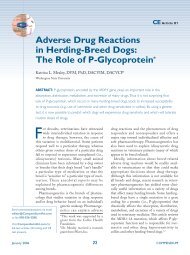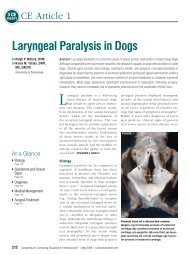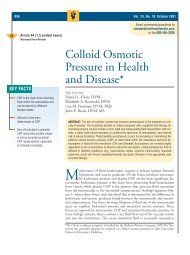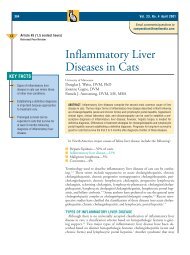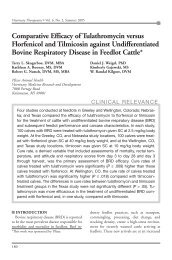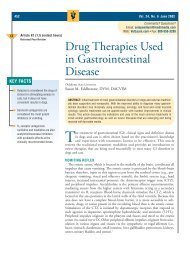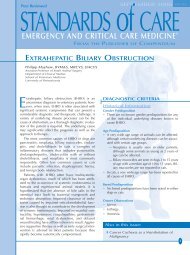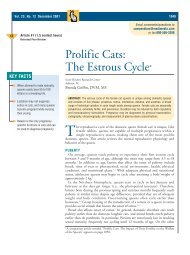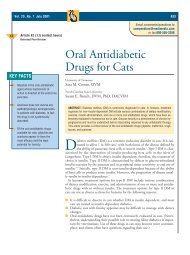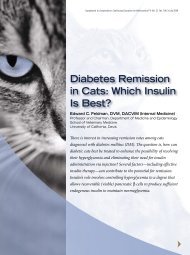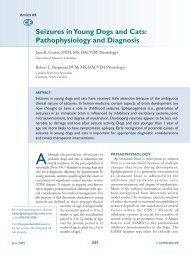Wall-July PV-Review - VetLearn.com
Wall-July PV-Review - VetLearn.com
Wall-July PV-Review - VetLearn.com
- TAGS
- cp.vetlearn.com
You also want an ePaper? Increase the reach of your titles
YUMPU automatically turns print PDFs into web optimized ePapers that Google loves.
622 Small Animal/Exotics Compendium August 2002<br />
Table 1. Antimicrobial Re<strong>com</strong>mendations for Bacteria Commonly Isolated in Dogs with Infective<br />
Endocarditis 9–11,13,14,42,48–50<br />
Antibiotic Staphylococci a Streptococci Gram-Negative Organisms Anaerobes<br />
Cephalosporins<br />
First generation S S V R<br />
Second generation S S V Gram negative<br />
Third generation<br />
Cefotaxime b V S S c S<br />
Ceftiofur d V V V V<br />
Penicillin G R S R S<br />
Ampicillin R S V V<br />
Amoxicillin–clavulanate V S V S<br />
Ticarcillin e S S V V<br />
Ticarcillin–clavulanate f S S S S<br />
Fluoroquinolones S V S R<br />
Aminoglycosides S V S R<br />
Clindamycin g V S R S<br />
a Coagulase-positive staphylococci.<br />
b Claforan ® , Hoechst Marion Roussel.<br />
c Pseudomonas resistant.<br />
d Naxcel ® , Pharmacia and Upjohn Co.<br />
e Ticar ® , GlaxoSmithKline.<br />
f Timentin ® , GlaxoSmithKline.<br />
g Cleocin ® , Pharmacia and Upjohn Co.<br />
R = usually resistant; S = usually sensitive; V = Variable sensitivity; use only if indicated by antibiogram.<br />
coside. 49 Clindamycin or metronidazole administration<br />
extends the anaerobic spectrum. A good <strong>com</strong>bination is<br />
clindamycin plus enrofloxacin. Aminoglycoside therapy<br />
duration should be limited to 5 to 7 days because renal<br />
toxicity is possible and concurrent fluid support is necessary<br />
8–11 (Table 2).<br />
The choice for SC antibiotic administration should<br />
ideally be based on an antibiogram, but if blood cultures<br />
are negative or not performed, ceftiofur (2.2<br />
mg/kg SC q12h), azithromycin (5 mg/kg SC q12h), or<br />
ticarcillin (50 to 100 mg/kg SC q8h) may be used. 14<br />
We re<strong>com</strong>mend that blood cultures be performed 4<br />
weeks after treatment to ensure eradication of the<br />
organism. Patients, including those with negative cultures,<br />
are monitored for improvement via constitutional<br />
signs, serial CBC and serum chemistry profiles,<br />
and echocardiography. The emergence of overt CHF is<br />
ominous. Although it may offer temporary amelioration<br />
of signs, glucocorticoid administration is associated<br />
with decreased survival. 6<br />
Supportive therapy is always a <strong>com</strong>ponent of treatment.<br />
Acid–base, fluid, and electrolyte balance must<br />
be addressed. Nutritional support may be an important<br />
<strong>com</strong>ponent of therapy and may be maintained by<br />
either parenteral or tube alimentation. The consequences<br />
of valvular destruction must be addressed.<br />
www.<strong>VetLearn</strong>.<strong>com</strong><br />
Although a positive influence on disease progression is<br />
unproven, 51 angiotensin-converting enzyme (ACE)<br />
inhibition is usually re<strong>com</strong>mended if there is unequivocal<br />
left-atrial or left-ventricular enlargement.<br />
Enalapril (0.25 mg/kg PO q12h for 1 week followed<br />
by 0.5 mg/kg PO q12h) or benazepril (0.25 mg/kg PO<br />
q24h for 1 week followed by 0.5 mg/kg PO q24h) are<br />
<strong>com</strong>mon choices. Spironolactone (1 to 2 mg/kg PO<br />
q12h), an aldosterone antagonist, may be added to the<br />
regimen as cardiac enlargement progresses. A diuretic<br />
and digoxin (0.005 to 0.01 mg/kg PO q12h) should<br />
be used if CHF is overt. Again, the influence of<br />
digoxin on disease progression may be negligible. 52<br />
Furosemide (1 to 4 mg/kg PO q12h) is the diuretic of<br />
choice. A serum digoxin concentration should be<br />
obtained after 7 days of treatment from a sample<br />
drawn at 6 hours after the morning dose. For most<br />
laboratories, a desirable serum digoxin concentration is<br />
1 to 1.5 ng/ml. Renal function and serum electrolyte<br />
monitoring at 1 to 2 weeks and then monthly is re<strong>com</strong>mended.<br />
Augmented afterload reduction may be a<br />
useful adjunct to ACE inhibition. Adjuvant afterload<br />
reduction (arteriolar dilation) may result in reduction<br />
of aortic or mitral regurgitant volume. When the total<br />
peripheral arteriolar resistance is decreased by increasing<br />
the total arteriolar cross-sectional area, the change



